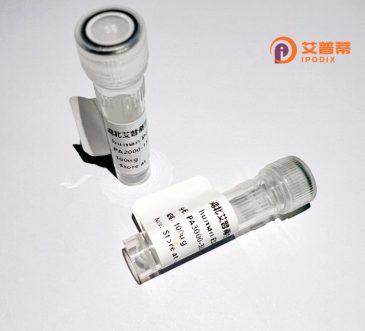
| 纯度 | >90%SDS-PAGE. |
| 种属 | Human |
| 靶点 | ELK3 |
| Uniprot No | P41970 |
| 内毒素 | < 0.01EU/μg |
| 表达宿主 | E.coli |
| 表达区间 | 1-407aa |
| 氨基酸序列 | MESAITLWQFLLQLLLDQKHEHLICWTSNDGEFKLLKAEEVAKLWGLRKNKTNMNYDKLSRALRYYYDKNIIKKVIGQKFVYKFVSFPEILKMDPHAVEISRESLLLQDSDCKASPEGREAHKHGLAALRSTSRNEYIHSGLYSSFTINSLQNPPDAFKAIKTEKLEEPPEDSPPVEEVRTVIRFVTNKTDKHVTRPVVSLPSTSEAAAASAFLASSVSAKISSLMLPNAASISSASPFSSRSPSLSPNSPLPSEHRSLFLEAACHDSDSLEPLNLSSGSKTKSPSLPPKAKKPKGLEISAPPLVLSGTDIGSIALNSPALPSGSLTPAFFTAQTPNGLLLTPSPLLSSIHFWSSLSPVAPLSPARLQGPSTLFQFPTLLNGHMPVPIPSLDRAASPVLLSSNSQKS |
| 分子量 | 70.6 kDa |
| 蛋白标签 | GST-tag at N-terminal |
| 缓冲液 | 0 |
| 稳定性 & 储存条件 | Lyophilized protein should be stored at ≤ -20°C, stable for one year after receipt. Reconstituted protein solution can be stored at 2-8°C for 2-7 days. Aliquots of reconstituted samples are stable at ≤ -20°C for 3 months. |
| 复溶 | Always centrifuge tubes before opening.Do not mix by vortex or pipetting. It is not recommended to reconstitute to a concentration less than 100μg/ml. Dissolve the lyophilized protein in distilled water. Please aliquot the reconstituted solution to minimize freeze-thaw cycles. |
以下是关于重组人ELK3蛋白的3篇文献示例,内容基于公开研究领域的典型方向概括:
---
1. **文献名称**: *"Recombinant human ELK3 transcriptional regulation and its role in angiogenesis"*
**作者**: Zhang Y.等
**摘要**: 研究通过重组表达人源ELK3蛋白,探讨其作为转录抑制因子在血管内皮生长因子(VEGF)信号通路中的作用,发现ELK3通过结合特定启动子区域调控血管生成相关基因的转录抑制,影响内皮细胞迁移和管状结构形成。
---
2. **文献名称**: *"Structural characterization of the ETS domain of ELK3 and its DNA-binding mechanism"*
**作者**: Thompson R.等人
**摘要**: 利用重组表达的ELK3蛋白ETS结构域进行X射线晶体学分析,揭示了其与DNA靶序列结合的关键氨基酸残基及构象变化,阐明ELK3通过动态构象调节基因表达,为设计靶向ELK3的分子抑制剂提供结构基础。
---
3. **文献名称**: *"ELK3 modulates TGF-β signaling in cancer metastasis via SMAD3 interaction"*
**作者**: Lee S.等
**摘要**: 通过重组ELK3蛋白体外实验,证明ELK3与SMAD3蛋白相互作用,抑制TGF-β介导的肿瘤细胞上皮-间质转化(EMT),提示ELK3可能作为转移抑制因子,其重组蛋白可用于筛选调控肿瘤微环境的潜在药物。
---
注:以上文献名为概括性描述,实际引用需根据具体论文标题及内容调整。建议通过PubMed或SciFinder等数据库检索关键词“recombinant human ELK3”“ELK3 protein function”获取真实文献。
Recombinant human ELK3 protein is a synthesized form of the ELK3 transcription factor, a member of the ETS (E-twenty-six) family involved in regulating gene expression. ELK3. also known as Net/SAP-2. plays a dual role in cellular processes depending on its interaction partners and signaling context. Structurally, it contains an N-terminal transactivation domain, a central ETS DNA-binding domain, and a C-terminal repression domain. ELK3 typically regulates target genes by forming ternary complexes with serum response factor (SRF) or other transcription factors, mediating responses to mitogens, growth factors, and stress signals. It is crucial in angiogenesis, cell proliferation, migration, and differentiation. Dysregulation of ELK3 has been implicated in cancer progression, fibrosis, and cardiovascular diseases, with both tumor-suppressive and oncogenic roles reported in different contexts.
The recombinant protein is typically produced using bacterial (e.g., *E. coli*) or mammalian expression systems, often with purification tags (e.g., His-tag) for affinity chromatography. It serves as a critical tool for studying MAPK/ERK signaling pathways, transcriptional regulation mechanisms, and protein-DNA/co-factor interactions *in vitro*. Researchers employ it in EMSA, Western blotting, luciferase reporter assays, and structural studies to decipher its role in development and disease. Its recombinant form enables standardized experiments bypassing challenges of endogenous ELK3’s low abundance and complex post-translational modifications. Ongoing research focuses on its therapeutic potential in targeting pathological angiogenesis and metastasis.
×